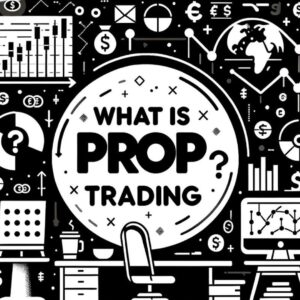Introduction to Starting Your Own Prop Firm
Learning how to start a prop firm in the current financial landscape can be an exciting journey, offering a pathway to success in the booming industry of proprietary trading. Proprietary trading firms, known for their dynamic and profitable nature, have gained significant attention following regulatory changes, such as the European Securities and Markets Authority’s (ESMA) tightening of Contracts for Difference (CFD) trading regulations. This has led many FX and CFD brokers to either integrate prop trading into their existing business models or pivot entirely to this lucrative sector. With this backdrop, the prop trading industry has experienced a renaissance, as these firms aren’t as heavily regulated compared to traditional brokerages, allowing more flexibility in their operations.
Starting a prop trading firm now could be a strategic move, tapping into the potential of an industry that is increasingly accessible yet complex. In this article, we’ll delve into the essentials, guiding you through both how to start a prop firm and how to set up a prop firm, highlighting the critical elements to consider at each stage.
Understanding the Essentials of Proprietary Trading

Proprietary trading, often abbreviated as prop trading, plays a pivotal role in the financial markets, involving firms that utilize their capital to trade in equities, currencies, commodities, and other financial instruments. This trading model is unique because the firm assumes direct risk and reward from its trading activities, distinguishing it from client-driven trading. Here’s a deeper look into what prop trading entails and its significance in the financial ecosystem.
Proprietary Trading Defined
Prop trading occurs when a firm trades stocks, bonds, currencies, commodities, derivatives, or other financial instruments with its own money, as opposed to using clients’ funds, aiming to make a profit for itself. This autonomy allows prop firms to execute swift, flexible trading strategies that can capitalize on market fluctuations and opportunities.
Historical Perspective and Market Impact
The concept of prop trading has evolved significantly, especially with the advent of electronic trading platforms. In the past, these firms were mostly hidden within the larger operations of investment banks and hedge funds. However, regulatory changes post-financial crisis have led to the emergence of standalone prop trading firms that contribute actively to market liquidity, price discovery, and the overall stability of the financial system.
Advantages for Firms and Traders
For the firms, prop trading is lucrative, providing high returns on capital without the complexities of client management. It also plays a critical role in the financial markets by adding liquidity, aiding in price discovery, and facilitating efficient market functioning. For traders, prop trading offers the chance to handle significant capital, exposing them to larger profit (and risk) potentials. It also serves as a platform for honing trading skills, given the professional environment and the exposure to various trading strategies and market scenarios.
Starting A Prop Trading Firm
Launching a prop trading firm involves several key steps, from industry research to strategic planning and fulfilling legal obligations. Let’s explore these critical phases to help establish a solid foundation for your prop trading business.
Initial Considerations and Learning About the Industry
Before diving into the prop trading world, it’s crucial to gain a comprehensive understanding of the financial industry and the specific niche of proprietary trading. This includes studying market trends, understanding the competitive landscape, and recognizing the operational nuances of prop trading firms. Networking with industry professionals, attending seminars, and participating in trading forums can provide invaluable insights and facilitate a deeper understanding of the market dynamics.
Detailed Business Strategy Development
Creating a detailed business strategy is the cornerstone of starting a successful prop trading firm. This strategy should encompass your firm’s objectives, trading philosophy, target markets, and operational structure. Key components of a business plan include:
- Trading Strategies: Define the types of trading activities your firm will engage in, such as day trading, swing trading, algorithmic trading, or a mix of these strategies.
- Risk Management: Outline your approach to managing trading risks, including setting stop-loss limits, maximum drawdown rules, and other risk control measures.
- Capital Allocation: Determine how much capital you will allocate to different trading activities and how you will manage the fund’s growth.
- Technology and Infrastructure: Plan the technology and infrastructure needed for trading operations, including trading platforms, data analysis tools, and back-office systems.
- Human Resources: Identify the key roles within your firm and the expertise required to fill these positions effectively.
Legal Requirements and Licensing for Prop Trading
The legal framework governing prop trading firms varies by country and region. It’s imperative to understand the specific legal requirements and regulatory landscape of the jurisdiction in which you plan to operate. In the United States, for example, proprietary trading is subject to regulations by entities like the Securities and Exchange Commission (SEC) and the Financial Industry Regulatory Authority (FINRA).
To legally operate a prop trading firm, you may need to:
- Register Your Firm: Obtain the necessary business licenses and registrations for your firm.
- Compliance: Ensure compliance with trading regulations and standards, which may involve periodic audits, transparent trading practices, and maintaining adequate capital reserves.
- Licensing: Acquire the specific licenses required for proprietary trading, which may include trader licensing, depending on your location and the nature of your trading activities.
Starting a prop trading firm requires thorough preparation, from gaining industry knowledge to developing a robust business plan and adhering to legal and regulatory standards. By addressing these elements systematically, you can establish a strong foundation for a successful and compliant proprietary trading enterprise.
Establishing a successful proprietary trading firm goes beyond conceptual planning and enters the realm of operational execution. This involves setting up the right technology and infrastructure, building a competent team, and implementing effective risk management strategies.
Technology and Infrastructure Setup
The backbone of any prop trading firm is its technology and infrastructure, which facilitate efficient trading operations and risk management. Essential components include:
- Trading Platforms: Choose platforms that offer speed, reliability, and a range of analytical tools. These platforms should support the trading strategies your firm intends to use, whether they’re manual, automated, or a combination of both.
- Market Data Access: Ensure real-time access to market data across the financial instruments your firm will trade. This includes price feeds, news, and economic indicators.
- Back-Office Systems: Invest in back-office technology for trade reconciliation, accounting, and reporting. This ensures regulatory compliance and helps in monitoring the firm’s financial health.
- Communication and Security: Implement secure and efficient communication systems to connect your team and safeguard sensitive data against cybersecurity threats.
Hiring and Organizational Structure for Operations
Your firm’s success also depends on the talent and organization of your team. Key considerations include:
- Dealing Department: Responsible for managing trading activities, monitoring positions, and ensuring compliance with risk parameters.
- Technology Support: IT specialists who maintain and optimize trading and back-office systems.
- Risk Management: Professionals skilled in identifying, analyzing, and mitigating risks associated with trading activities.
- Administrative and Support Staff: Essential for the smooth operation of non-trading-related activities.
Structure your organization to promote effective communication and operational efficiency, with clear roles and responsibilities.
Risk Management Strategies and Tools
Risk management is vital in proprietary trading to protect the firm from unexpected market movements and financial losses. Implementing robust risk management strategies involves:
- Risk Limits: Establishing trading limits, such as stop-loss orders, maximum drawdown levels, and daily or monthly loss limits to control potential losses.
- Continuous Monitoring: Real-time monitoring of trading activities to identify and address risks promptly.
- Diversification: Spreading investment across different assets or strategies to reduce risk exposure.
- Stress Testing and Scenario Analysis: Regularly testing the firm’s strategies against various market conditions to ensure they can withstand extreme market events.
By setting up a robust operational foundation, a prop trading firm can navigate the complexities of the financial markets more effectively. This includes leveraging advanced technology, assembling a skilled team, and adhering to strict risk management practices, ensuring both operational excellence and financial integrity.
Financial Planning and Management
A prop trading firm’s financial health is crucial to its longevity and success. Understanding the costs involved, managing profitability, and structuring trader fees and funding are essential aspects of financial planning and management.
Cost Analysis for Setting Up a Prop Trading Firm The initial setup cost for a prop trading firm can vary widely based on location, size, and technological needs. Key expenses include:
- Technology Infrastructure: Investment in trading platforms, market data subscriptions, and back-office systems.
- Legal and Regulatory Compliance: Costs associated with registration, licensing, and ongoing compliance monitoring.
- Premises and Equipment: Physical office space and trading equipment, unless opting for a virtual setup.
- Marketing and Branding: Initial marketing efforts to attract traders and establish the firm’s presence in the market.
- Human Resources: Salaries, benefits, and training costs for staff.
An initial budget in the range of $15,000 to $100,000 is a realistic estimate for most startups, excluding the significant capital required for funding trading activities.
Fee Structures and Funding Models for Traders
Prop firms typically use various fee structures and funding models to manage their financial risks and incentivize traders, such as:
- Sign-up Fees: Charging traders an upfront fee to participate in funding programs, offsetting the firm’s evaluation and operational costs.
- Profit Sharing: Implementing a profit-sharing model where the firm retains a portion of the trading profits generated by its traders.
- Subscription Models: Offering monthly or annual subscriptions that provide traders with access to the firm’s capital and resources.
When evaluating a prop firm, customers consider these key factors: Trustworthiness to ensure reliability, favorable trading conditions for optimal performance, and competitive pricing for cost efficiency.
Cheaper Way to Setting Up a Prop Trading Firm

Initial Setup
Starting a prop trading firm usually kicks off with getting registered and teaming up with known brokers or platforms like Eightcap or ThinkMarkets. These collaborations often involve leveraging white-label solutions that facilitate the setup of your trading enterprise efficiently. This step is about putting the basics in place, costing somewhere around $5,000 to $10,000. This initial fund is mainly for getting your business structure ready and setting up your website with the help of your chosen partners.
Marketing and Building Your Brand
After your firm is up and running, the next big task is to bring in the traders. Marketing costs can swing widely based on how big or small your operations are. Smaller setups might need between $10,000 and $30,000, while bigger ones could be looking at $50,000 to $100,000. Here are some smart ways to market:
- Using Twitter influencers to get people talking.
- Running contests or giveaways to get noticed.
- Setting up targeted ads on Facebook.
- Making a catchy video for your brand, possibly for as little as $500 on platforms like Fiverr.
- Boosting your online findability with SEO and Google Ads.
If you already have a community or network, you can cut down on these costs significantly.
Funding the Traders
Next up is the funding stage, where you can provide traders with a starting ‘virtual’ funds. However, it’s crucial to know that a large chunk, usually over 95%, might not make it through the trading challenges set by your firm.
Extra Points to Consider in Prop Trading
When running a prop trading firm, there’s more to it than just the setup and day-to-day trading. Here’s what else you need to think about:
Back Office Capabilities: Many prop firms use a back office system. This setup lets them keep an eye on trading activities and, if needed, adjust or penalize accounts. For traders doing exceptionally well, the firm might adjust trading conditions (like introducing slippage) to manage risk and profits.
Financial Reporting: Prop firms often report big numbers when it comes to withdrawals, but these figures can be influenced by several factors. For instance, non-disclosure agreements (NDAs), marketing tactics, or partnerships with trading mentors might inflate these numbers to build the firm’s reputation.
While prop trading offers significant opportunities, maintaining transparency and fairness is key to ensuring a trustworthy and sustainable business environment. This insight is not a critique of prop trading as a business model but rather a call to acknowledge and navigate its intricacies responsibly.
Marketing and Growth Strategies for Prop Trading Firms
In the competitive landscape of proprietary trading, effective marketing and growth strategies are essential to attract and retain clients. Here’s how prop firms can excel in these areas:
Importance of Marketing in Attracting Clients
Marketing is the lifeblood of a prop trading firm, vital for drawing in talented traders and establishing a market presence. Without a strong marketing approach, even the most well-equipped firm might struggle to find clients.
Strategies for Branding and Client Engagement
Creating a strong brand identity and actively engaging with potential clients are key steps to stand out in the prop trading world. Here’s how:
- Develop a Unique Value Proposition (UVP): Clearly communicate what sets your firm apart from the competition, whether it’s superior technology, better trading conditions, or unique funding opportunities.
- Create Compelling Content: Use blogs, webinars, and e-books to showcase your expertise and provide valuable insights to traders.
- Build Community: Engage with your audience through forums, social media groups, or in-person events to foster a sense of community and loyalty.
Leveraging Social Media and Digital Marketing
Social media and digital marketing are powerful tools for reaching a broad audience at a relatively low cost. Here’s how to leverage them effectively:
- Social Media Platforms: Use platforms like Twitter, LinkedIn, and Instagram to share success stories, market analysis, and trading tips. This can help build your brand’s authority and attract potential clients.
- Digital Advertising: Invest in targeted ads on platforms like Google, Facebook, and YouTube to reach potential traders who are looking for prop trading opportunities.
- SEO Optimization: Ensure your website and content are optimized for search engines to increase visibility and attract organic traffic.
The Role of Technology in Proprietary Trading
Technology plays a critical role in the success of proprietary trading firms, influencing trading efficiency, risk management, and overall operational effectiveness. Here’s how technology integrates into prop trading:
Essential Technology and Tools for Operational Success
To thrive in the fast-paced world of prop trading, firms need access to the following technological tools:
- Advanced Trading Platforms: These platforms are the core of prop trading operations, offering features like real-time market data, quick trade execution, and advanced charting tools.
- Risk Management Software: Essential for monitoring and managing the risks associated with trading activities, helping firms set limits and alerts to prevent significant losses.
- Analytical Tools: Software that provides in-depth market analysis, including historical data and predictive analytics, to aid in decision-making.
- Communication Tools: Efficient internal and external communication systems to ensure seamless operations and client interactions.
Choosing the Right Technology Partner and Considerations
Selecting a technology partner is a strategic decision that can significantly affect the firm’s future growth and stability. Consider the following when choosing a technology provider:
- Reputation and Reliability: Choose a partner known for their reliability and positive track record in the financial trading industry.
- Scalability: The technology should be able to grow with your business, accommodating increased trading volumes and complexity without compromising performance.
- Support and Service: Look for providers who offer robust customer support and training to ensure you can maximize the use of their technology.
- Compliance and Security: Ensure the technology adheres to industry standards for data security and regulatory compliance, protecting your firm and clients from cyber threats and legal issues.
Impact of Technology on Trading Efficiency and Risk Management
Technology can dramatically enhance trading efficiency and the effectiveness of risk management strategies:
- Trading Efficiency: Modern trading platforms enable rapid execution of trades, minimizing slippage and ensuring the best possible outcomes for trading strategies.
- Risk Management: Automated risk management tools can instantly respond to market changes, implementing stop-loss orders and other risk control measures to protect the firm’s capital.
Incorporating the right technology and tools is essential for proprietary trading firms to navigate the market effectively, manage risks, and achieve operational success.
The Advantages of Proprietary Trading
Proprietary trading offers a range of financial and strategic benefits for both the firms and individual traders. Understanding these advantages is key to maximizing the potential of a prop trading firm.
Financial and Strategic Benefits for Firms and Traders
- Capital Efficiency: Prop firms use their capital to generate profits, allowing them to leverage their financial resources efficiently.
- High Profit Potential: With access to substantial capital, traders can pursue larger and more diverse trading opportunities, leading to potentially higher profits.
- Direct Market Access: Prop trading provides direct access to financial markets, enabling quicker decision-making and execution of trades.
Contributions to Market Liquidity and Stability
- Enhancing Liquidity: By actively trading a variety of instruments, prop firms contribute to the depth and liquidity of financial markets, making it easier for other participants to trade.
- Stabilizing Markets: Prop traders help stabilize market prices through arbitrage and other strategies, reducing volatility and promoting price discovery.
Opportunities for Learning and Professional Development
- Skill Enhancement: Traders in prop firms are exposed to a wide range of trading strategies and financial instruments, allowing them to develop and refine their trading skills.
- Mentorship and Collaboration: Many prop trading firms provide mentorship programs and collaborative environments where traders can learn from experienced professionals and peers.
- Career Advancement: Successful traders at prop firms often have opportunities for career progression, moving into more senior trading or management roles.
Proprietary trading not only fosters a dynamic and profitable trading environment but also contributes significantly to the broader financial markets by enhancing liquidity and stability. Additionally, it offers traders a platform for continuous learning and professional growth, making it a compelling model in the world of finance.
High Frequency Trading in Prop Firms: A Closer Look

High Frequency Trading (HFT) within prop firms is like a high-speed puzzle that only the best can solve. These firms often seem open and easy to join, with rules that appear straightforward. However, beneath this welcoming exterior, they enforce tough standards that quickly filter out less experienced traders.
Not as Easy as It Seems
Prop firms attract a sea of traders with the initial promise of easy entry, particularly enticing those fascinated by the quick action of HFT. But the reality is a bit like a hidden obstacle course: the rules are stricter than they first appear. This setup ensures that only the most skilled traders, who can navigate the fast-paced world of HFT, remain.
The Magnetic Pull of HFT
HFT is like a magnet in the trading world, drawing people in with the prospect of fast profits and high-tech trading. Prop firms known for supporting HFT are especially popular, getting lots of praise from successful traders, which in turn attracts more people. Yet, despite the buzz, the truth is that these firms set very high standards, making real success during the funding stage quite challenging.
Attracting Many, Selecting Few
A prop firm that supports HFT can quickly become the center of attention, drawing thousands of traders each month with its tech-savvy image and success stories. However, this influx is also because the firm is seen as a place where the best of the best trade, despite the rigorous standards they impose.
Conclusion: Key Steps to Starting A Proprietary Trading Firm
Starting a prop trading firm is a journey that requires careful planning, strategic decision-making, and the right technological support. Here’s a recap of the essential steps and considerations for establishing a successful prop trading firm:
- Understand the Basics: Get to know the prop trading industry, including its benefits and challenges.
- Develop a Solid Plan: Outline your business strategy, including financial planning, marketing approaches, and operational structure.
- Leverage Technology: Invest in the right technology and infrastructure to support efficient trading and effective risk management.
- Choose the Right Partners: Collaborate with reliable technology providers and liquidity sources to enhance your trading capabilities and market access.
- Stay Compliant: Adhere to regulatory requirements to ensure your firm operates legally and maintains a good reputation.
The pivotal role of technology in prop trading cannot be overstated. It’s the backbone that supports trading activities, risk management, and overall firm operations. Selecting the right partners, from technology providers to liquidity sources, is equally critical. These partnerships can be the difference between a firm that thrives and one that struggles.
While the world of proprietary trading is competitive and fast-paced, with the right approach and resources, it is possible to establish and grow a successful prop trading firm. Remember, success in this field is not just about financial capital; it’s also about intellectual capital, strategic foresight, and the continuous pursuit of excellence.





